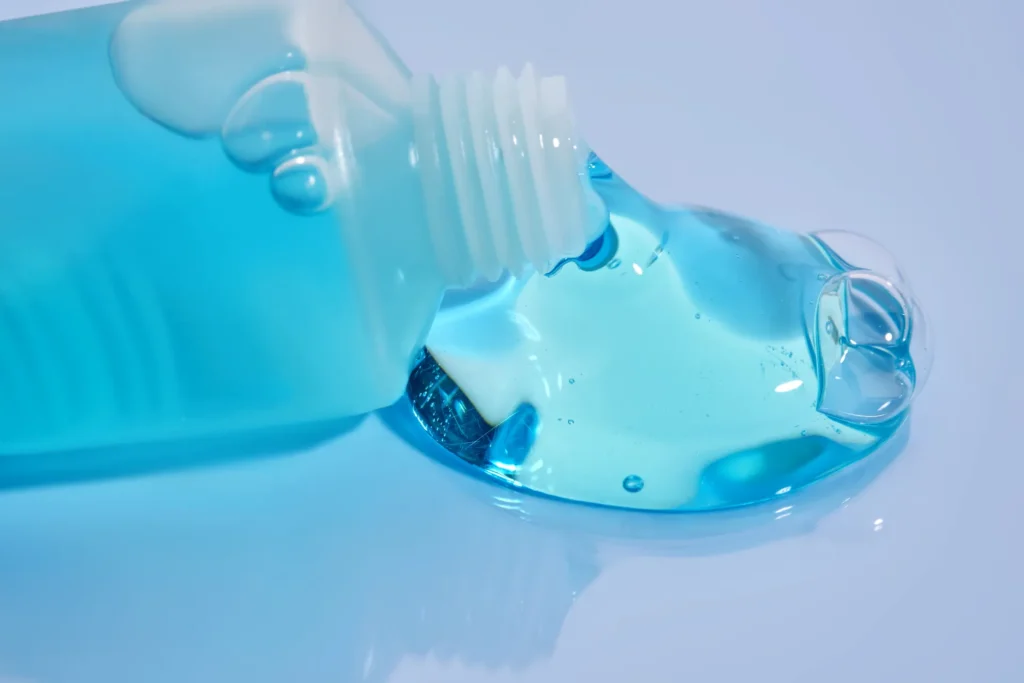Tooth extraction, whether routine or due to complications like wisdom tooth removal, requires careful attention to post-operative care. Understanding when and how to use mouthwash after tooth extraction is crucial for optimal healing, particularly in the context of gauze and maintaining cleanliness.
Why Is Timing Important For Using Mouthwash After A Tooth Extraction?
Timing is essential when considering the use of mouthwash after a tooth extraction, especially the day after surgery.
The initial days following the procedure are critical for the healing process, as the extraction site needs to develop a blood clot to prevent complications such as dry socket.
Understanding The Healing Process After Tooth Extraction
After a Tooth Extraction, your body initiates a natural healing process that involves the formation of a blood clot at the extraction site. This clot serves to protect the underlying gum and bone, providing a foundation for new tissue to grow, which is crucial after a tooth extracted.
If proper care is not taken during this delicate time, including avoiding vigorous rinsing, the clot may dislodge, leading to increased pain and potential infections.
Risks Of Using Mouthwash Too Soon After Oral Surgery
Using mouthwash too soon after oral surgery can pose several risks. Vigorous rinsing or using certain mouthwash ingredients can disturb the blood clot, increasing the likelihood of complications.
This can result in severe pain or prolonged healing, which can negatively impact your overall oral health and potentially lead to gum disease.
Importance Of Blood Clot Formation In The Extraction Site
The formation of a blood clot at the extraction site is paramount for proper healing, particularly after a tooth is pulled, and it is advisable to use an ice pack to reduce swelling. It acts as a barrier against bacteria and aids in tissue regeneration.
Dislodging this clot, especially within the first 48 hours, can lead to painful conditions like dry socket, which complicates recovery and may necessitate further dental intervention.
How Long Should You Wait Before Using Mouthwash After Tooth Extraction?
Determining the appropriate waiting period before you can safely use mouthwash after tooth extraction is vital for recovery.
Typically, dentists recommend abstaining from mouthwash for at least 24 hours to allow the blood clot to stabilize and the healing process to begin properly.
First 24 Hours Post-Extraction: What To Avoid
During the first 24 hours post-extraction, it is crucial to avoid using mouthwash, as well as vigorous rinsing or brushing around the extraction site. Instead, gentle rinsing with warm saltwater can help maintain oral hygiene without disturbing the healing process.
You should also avoid flossing near the area to prevent dislodging the blood clot.
Recommended Timeline For Introducing Mouthwash
After the first 24 hours, you may begin to cautiously use mouthwash after wisdom tooth removal, but it is vital to choose a gentle, alcohol-free formula.
It is generally recommended to wait about 48 hours before resuming regular oral hygiene practices, such as using mouthwash, to ensure that the blood clot has adequately formed and the risk of complications is minimized.
Differences In Timing For Regular Extractions Vs. Wisdom Tooth Removal
The timing for using mouthwash after regular tooth extractions can differ from wisdom tooth removal.
Wisdom teeth, due to their complex extraction process, may require a longer healing time. It is often advised to wait a full week or even up to 10 days before reintroducing mouthwash to prevent any disturbances to the extraction site, especially after a tooth extracted.
What Are Safe Alternatives To Mouthwash During The Initial Healing Period?
During the initial healing period after a tooth extraction, it is essential to maintain good oral hygiene while avoiding any products that could disrupt the healing process.
There are several safe alternatives to mouthwash that you can utilize to keep your mouth clean.
Benefits Of Saltwater Rinses For Oral Hygiene
One of the most effective and dentist-approved methods during the initial healing phase is a warm saltwater rinse.
Mixing a teaspoon of salt with warm water can help reduce inflammation, promote healing, and cleanse the mouth without disturbing the blood clot. This gentle rinse can be performed multiple times a day to support oral hygiene.
How To Properly Perform A Gentle Mouth Rinse
To perform a gentle mouth rinse, take a small sip of the saltwater solution and swish it around your mouth carefully, avoiding vigorous movements, as this can help keep your mouth clean.
After swishing for about 30 seconds, spit the solution out gently. This method helps to keep the extraction area clean without risking the dislodgment of the blood clot.
Other Dentist-Approved Methods To Keep Your Mouth Clean
In addition to saltwater rinses, there are other dentist-approved methods to maintain oral health during recovery. Using a soft-bristled toothbrush can help you brush your teeth gently while avoiding the extraction site.
Additionally, avoiding hard or crunchy foods and maintaining hydration can support overall healing and comfort.
How Can You Maintain Oral Hygiene Without Mouthwash After Tooth Extraction?

Maintaining oral hygiene after a tooth extraction is crucial for a successful recovery. While mouthwash can be beneficial, there are several effective methods to ensure your mouth remains clean without it.
Brushing And Flossing Techniques During Recovery
During the initial days following your tooth extraction, it’s essential to adapt your brushing and flossing techniques to protect the extraction site. Use a soft-bristled toothbrush to gently brush your teeth, avoiding the area of the extraction to prevent disturbing the blood clot.
Flossing should also be approached with caution; it’s best to avoid the extraction site for at least a week to minimize the risk of dislodging the blood clot. This careful attention ensures good oral hygiene while allowing the healing process to progress without complications.
Tips For Cleaning Around The Extraction Site
Cleaning around the extraction site requires a delicate touch. After the first 24 hours, you can start to gently rinse your mouth with warm saltwater to help keep the area clean. This homemade saltwater rinse can be made by dissolving a teaspoon of salt in warm water.
Swish it around your mouth gently, being careful not to disturb the clot, especially within the first 24 hours after the extraction. Avoiding vigorous rinsing during the initial healing phase protects the extraction site and supports the healing process, ensuring that plaque does not accumulate around the gum area, especially near the extraction site.
When To Resume Normal Oral Care Routines
Resuming normal oral care routines is an important aspect of post-operative recovery. Typically, after 48 hours, it’s advisable to reintroduce gentle brushing and flossing into your routine, but with caution.
After wisdom tooth removal, the timeline might extend to 7 to 10 days, depending on the complexity of the extraction. Always follow your dentist’s specific instructions regarding when to use mouthwash and how to maintain your oral hygiene to avoid complications such as dry socket or infections.
What Types Of Mouthwash Are Best To Use After Tooth Extraction?
Choosing the right type of mouthwash after a tooth extraction can significantly influence your recovery.
Understanding the differences between various mouthwash options is key to supporting the healing process while maintaining oral hygiene.
Alcohol-Free Vs. Alcohol-Based Mouthwashes
When considering mouthwash options after tooth extraction, the choice between alcohol-free and alcohol-based formulas is vital. Alcohol-free mouthwash is preferred, as it is gentler on the healing gums and does not irritate the extraction site, helping keep your mouth clean.
In contrast, alcohol-based mouthwashes can cause dryness and discomfort, potentially hindering the healing process, particularly near the extraction site. Opting for an alcohol-free mouthwash helps maintain moisture in the mouth, supporting overall oral health during recovery.
Antiseptic Properties In Post-Extraction Oral Care
Mouthwashes with antiseptic properties can be beneficial for post-extraction oral care. These mouthwashes help reduce bacteria in the mouth, potentially lowering the risk of infections.
When selecting an antiseptic mouthwash, ensure it does not contain harsh chemicals that may disturb the healing process, especially the formation of a clot to form, which is critical within the first 24 hours. Gentle antiseptic mouthwashes can aid in keeping your mouth clean while promoting the formation of the blood clot, which is crucial for healing.
Dentist-Recommended Mouthwash Options For Healing
Your dentist may recommend specific mouthwash options tailored to support healing after tooth extraction, ensuring they do not replace daily brushing and flossing. Look for mouthwashes that are specifically designed for post-operative care, particularly those that support the healing process after a tooth pulled.
These may include fluoride-based formulas that help prevent tooth decay and promote oral health. Following your dentist’s recommendations can ensure you choose the right mouthwash to complement your recovery and maintain good oral hygiene.
What Are The Signs Of Complications When Using Mouthwash After Extraction?

Being aware of the signs of complications when using mouthwash after tooth extraction is essential for a smooth recovery. Recognizing these symptoms early can help you seek appropriate care and avoid further issues. For expert guidance on post-extraction care and tips to ensure a successful recovery, Personalized Blog is an excellent resource to turn to for reliable advice.
Symptoms Of Dry Socket and How to Prevent It
Dry socket is a painful condition that can occur after tooth extraction, often resulting from the dislodgment of the blood clot. Symptoms include severe pain radiating from the extraction site, bad breath, and an unpleasant taste in the mouth.
To prevent dry socket, avoid using mouthwash too soon, especially those containing alcohol, and refrain from vigorous rinsing. Following your dentist’s post-operative instructions will greatly reduce the risk of developing this complication.
When To Contact Your Dentist Or Oral Surgeon
If you experience persistent pain, swelling, or any unusual symptoms after using mouthwash post-extraction, it is crucial to contact your dentist or oral surgeon promptly. Signs of infection or complications need immediate attention to avoid further health concerns.
Regular follow-ups and open communication with your dental care provider ensure that any issues can be addressed swiftly, allowing for a smoother recovery.
Normal Vs. Abnormal Pain And Swelling During Recovery
Understanding the difference between normal and abnormal pain or swelling during recovery can significantly impact your healing process and is vital when considering dental implants.
While some discomfort and swelling are expected after tooth extraction, severe pain that worsens over time, or swelling that does not subside, could indicate complications. Monitoring your symptoms closely allows you to differentiate between normal healing responses and signs that may require professional evaluation.
How Does The Use Of Mouthwash Differ For Wisdom Tooth Extractions?
The use of mouthwash after wisdom tooth extractions requires special considerations due to the complexity of the procedure, especially within the first 24 hours.
Being aware of these differences is important for optimal healing and oral hygiene.
Special Considerations For Wisdom Teeth Removal
Wisdom tooth removal often involves a more extensive healing process compared to regular tooth extractions. As a result, post-operative care, including the use of mouthwash, should be approached with caution.
It is essential to wait longer, generally around 7 to 10 days, before reintroducing mouthwash. This timeframe allows for proper healing of the extraction site, reducing the risk of complications such as dry socket.
Extended Healing Time And Its Impact On Oral Care
Extended healing time following wisdom tooth extraction impacts your oral care routine. Patients may need to be more vigilant about their oral hygiene practices during this period, as the extraction sites can be more prone to infection.
Gentle brushing, saltwater rinses, and avoiding mouthwash until fully cleared by a dentist will help ensure that the healing process remains on track and that oral health is maintained.
Specific Instructions For Multiple Extractions
For patients undergoing multiple extractions, specific instructions from your dentist regarding the use of mouthwash are critical. Each extraction site requires care to prevent complications, and you may need to follow a tailored oral hygiene regimen.
This can include extended periods without using mouthwash and focusing on gentle cleaning methods to help keep your mouth clean without disturbing the blood clots from each extraction.



No Comment! Be the first one.